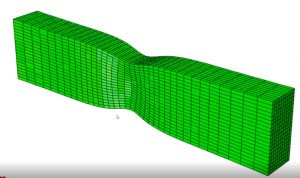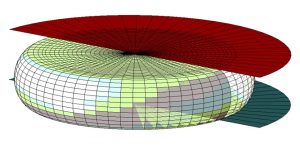This is a forward looking post, featuring some of the new things we are currently working on. All the common disclaimers apply, there may be reasons why this functionality is delayed, or even not released at all.
One of the new features under development is the ability to calibrate a material model based on the response of a FE mesh/model. This is going to be needed for calibration of damage and failure models. Another example where this is needed is for any experiment in which the state of stress/strain is non-homogeneous, such as in indentation testing,
This example uses a mesh of the center region of a dogbone specimen, meshed with 7200 C3D8R elements. This Abaqus/Standard model takes about 100 seconds to run on 1 cpu, or about 60 seconds to run on 2 cpus. Some synthetic test data was created using one particular Johnson-Cook plasticity model. Then this synthetic data was used to see if the calibration app could re-capture this “right answer” through running a series of Abaqus runs.

Want to see a narrated demonstration video showing this new feature being used in the development version of the calibration app? Log in to the SIMULIA Learning Community for more.
Another example we have used to test this new (not yet released) feature is the rubber puck example that was performed about 10 years ago using Isight driving a series of Abaqus runs. That example description can be found here:
Isight Calibration of a Bonded Rubber Puck

This example is much easier to perform using this new feature of the 3DX calibration app. It is also very well suited to this calibration process because the 96 element CAX4R mesh/model runs in only 4 seconds (using 1 cpu). One does need to be careful and NOT throw more cpu’s at this problem, because the performance will degrade. Details, including a demo video and the files needed are here:
3DX FE mesh/model calibration of the rubber puck
Another new feature we are working on is adding the capability to calibrate using DMA test data – storage & loss modulus data. We are hoping to release this with 2020x FD04, but it may be delayed. Please reference this post under the “Sharing Material Test Data” area. You will find the test data used and a demo video:
SIMULIA offers an advanced simulation product portfolio, including Abaqus, Isight, fe-safe, Tosca, Simpoe-Mold, SIMPACK, CST Studio Suite, XFlow, PowerFLOW and more. The SIMULIA Learning Community is the place to find the latest resources for SIMULIA software and to collaborate with other users. The key that unlocks the door of innovative thinking and knowledge building, the SIMULIA Learning Community provides you with the tools you need to expand your knowledge, whenever and wherever.


